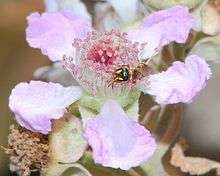Rubus ulmifolius subsp. sanctus
| Rubus ulmifolius subsp. sanctus | |
|---|---|
 | |
| Flower with a bee (Hylaeus rubicola) | |
| Scientific classification | |
| Kingdom: | Plantae |
| (unranked): | Angiosperms |
| (unranked): | Eudicots |
| (unranked): | Rosids |
| Order: | Rosales |
| Family: | Rosaceae |
| Genus: | Rubus |
| Subgenus: | Rubus |
| Species: | R. ulmifolius |
| Subspecies: | R. u. subsp. sanctus |
| Trinomial name | |
| R. ulmifolius subsp. sanctus (Schreb.) Sudre[1] | |
| Synonyms[2][3] | |
Rubus ulmifolius subsp. sanctus, commonly called holy bramble,[4] is a bramble native to parts of Asia and Europe.[2]
This plant is very long lived. An instance of it can be found at the Chapel of the Burning Bush on Mount Sinai, where it is revered as the original burning bush of the Bible. This longevity and location lead to its Latin name.[5] [6]
Chemistry
3,6-Di-O-caffeoylglucose, 1-O-caffeoylxylose and 2,3-O-hexahydroxydiphenoyl-4,6-O-sanguisorboyl-(α/β)-glucose (an ellagitannin constituted with sanguisorbic acid), are found in R. ulmifolius subsp. sanctus.[7]
References
- ↑ "Tropicos.org".
- 1 2 "USDA GRIN taxonomy".
- ↑ "The Plant List: A Working List of All Plant Species".
- ↑ "Rubus sanguineus". Wildflowers of Israel.
- ↑ "Places of Peace and Power". Retrieved 15 October 2014.
- ↑ "Chapel of the Burning Bush". Retrieved 15 October 2014.
- ↑ Caffeoyl sugar esters and an ellagitannin from Rubus sanctus. Sahar A.M Hussein, Nahla A Ayoub, Mahmoud A.M Nawwar, Phytochemistry, Volume 63, Issue 8, August 2003, Pages 905–911, doi:10.1016/S0031-9422(03)00331-5
| Wikimedia Commons has media related to Rubus sanguineus. |
| Wikispecies has information related to: Rubus ulmifolius subsp. sanctus |
This article is issued from Wikipedia - version of the 2/23/2016. The text is available under the Creative Commons Attribution/Share Alike but additional terms may apply for the media files.